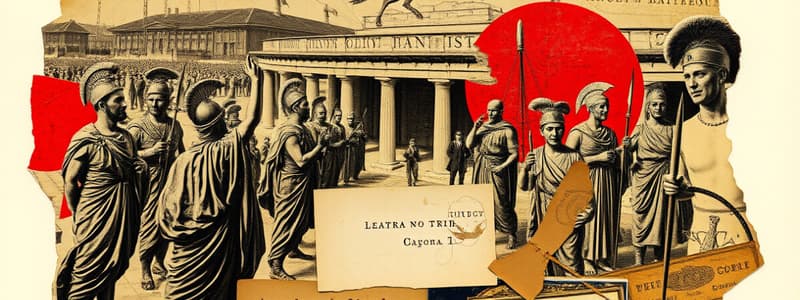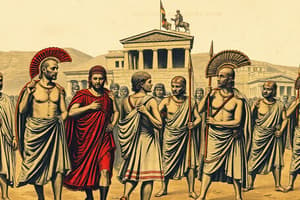Podcast
Questions and Answers
List the 3 social classes in Ancient Sparta.
List the 3 social classes in Ancient Sparta.
The Spartiates, The Perioiki, The Helots & Outcasts.
What are the criteria to become a member of the citizen class (a Spartiate)?
What are the criteria to become a member of the citizen class (a Spartiate)?
- Must be a direct descendant from the sons of Herakles (correct)
- Male, at least 30 years of age (correct)
- Must have military experience
- Must have wealth
Spartans were entitled to benefits such as ___.
Spartans were entitled to benefits such as ___.
Kleros, unlimited access to free meals and education.
What were the duties of the Spartiate class?
What were the duties of the Spartiate class?
Define the social class of the Spartiates.
Define the social class of the Spartiates.
Who were the Perioiki class?
Who were the Perioiki class?
What were the duties of the Perioiki class?
What were the duties of the Perioiki class?
What benefits did the Perioiki class receive?
What benefits did the Perioiki class receive?
What is the population of the Perioiki class?
What is the population of the Perioiki class?
What is the estimated population of the Helot class?
What is the estimated population of the Helot class?
Did Helots have legal or political standing within the Spartan community?
Did Helots have legal or political standing within the Spartan community?
Describe the Helot class.
Describe the Helot class.
Study Notes
Social Classes in Ancient Sparta
- Ancient Sparta had three main social classes:
- Spartiates: Legal Spartan citizens, equals, and peers.
- Perioiki: Non-Spartan citizens known as "Dwellers Around".
- Helots: Enslaved individuals and outcasts, primarily Messenian slaves and disgraced former Spartans.
Criteria for Spartiate Citizenship
- To become a Spartiate, candidates must meet specific conditions:
- Must be male, at least 30 years old.
- Required to prove ancestry, tracing lineage to the sons of Herakles.
- Must share common meals (syssitia) through military mess involvement.
- Successful completion of education and military training (Agoge) is mandatory.
Benefits of the Spartiate Class
- Spartiate citizens enjoyed various privileges:
- Ownership and inheritance of land (kleros) distributed by the government.
- Unlimited access to free meals and education.
- Prohibited from public labor, allowing focus on military and civic duties.
Duties of the Spartiate Class
- Spartiate responsibilities included:
- Defending against Helot uprisings.
- Protecting the city-state of Sparta from external threats.
- Emphasis on maintaining physical fitness to ensure strong offspring.
Characteristics of the Spartiates
- Upper class of Spartan society, consisting of roughly 750,000 - 100,000 individuals, the smallest demographic among the three classes.
Overview of the Perioiki Class
- Perioiki comprised free inhabitants in surrounding regions, autonomous yet subordinate to Sparta.
- They were primarily descendants of various city-states, lacked a say in Spartan governance or foreign policy.
Duties of the Perioiki Class
- Responsibilities included:
- Manufacturing and distributing weapons for the Spartan military.
- Engaging in mining and commerce.
- Obligated military service but received lesser training, often placed on the frontline to protect Spartiates.
Benefits of the Perioiki Class
- In return for military support, Perioiki received:
- Military protection from invaders.
- Allocation of land and political autonomy to manage their communities independently.
Perioiki Class Population
- The Perioiki class had approximately 120,000 members.
Helot Class Population
- The Helot class consisted of 170,000 - 224,000 individuals, contributing to labor to support Spartan citizens while living under harsh conditions to prevent uprisings.
Legal Status of Helots
- Helots held no legal or political rights within Spartan society.
- Crimes against Helots by Spartans were not prosecuted under Spartan law.
Description of the Helot Class
- The Helots were primarily Messenian individuals enslaved in 730 BC following the Spartan invasion.
- Also included were disgraced former Spartans stripped of citizenship for cowardice or criminal behavior.
Studying That Suits You
Use AI to generate personalized quizzes and flashcards to suit your learning preferences.
Description
Test your knowledge of the social classes in Ancient Sparta. This quiz includes essential information about the Spartiates, Perioiki, and Helots, exploring their roles and criteria for citizenship. Perfect for students of ancient history.




